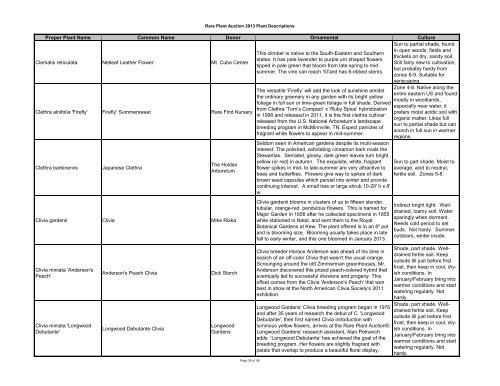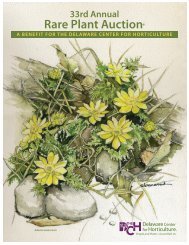Proper Plant Name Common Name Donor Ornamental Culture ...
Proper Plant Name Common Name Donor Ornamental Culture ...
Proper Plant Name Common Name Donor Ornamental Culture ...
You also want an ePaper? Increase the reach of your titles
YUMPU automatically turns print PDFs into web optimized ePapers that Google loves.
Rare <strong>Plant</strong> Auction 2013 <strong>Plant</strong> Descriptions<strong>Proper</strong> <strong>Plant</strong> <strong>Name</strong> <strong>Common</strong> <strong>Name</strong> <strong>Donor</strong> <strong>Ornamental</strong> <strong>Culture</strong>Clematis reticulata Netleaf Leather Flower Mt. Cuba CenterClethra alnifolia 'Firefly' Firefly' Summersweet Rare Find NurseryClethra barbinervisJapanese ClethraThe HoldenArboretumClivia gardenii Clivia Mike RiskaClivia miniata 'Anderson'sPeach'Clivia miniata 'LongwoodDebutante'Anderson's Peach CliviaLongwood Debutante CliviaDick StorchLongwoodGardensPage 29 of 98This climber is native to the South-Eastern and Southernstates. It has pale lavender to purple urn shaped flowerstipped in pale green that bloom from late spring to midsummer. The vine can reach 10'and has 6-ribbed stems.The versatile ‘Firefly’ will add the look of sunshine amidstthe ordinary greenery in any garden with its bright yellowfoliage in full sun or lime-green foliage in full shade. Derivedfrom Clethra ‘Tom’s Compact’ x ‘Ruby Spice’ hybridizationin 1998 and released in 2011, it is the first clethra cultivarreleased from the U.S. National Arboretum’s landscapebreeding program in McMinnville, TN. Expect panicles offragrant white flowers to appear in mid-summer.Seldom seen in American gardens despite its multi-seasoninterest. The polished, exfoliating cinnamon bark rivals theStewartias. Serrated, glossy, dark green leaves turn brightyellow (or red) in autumn. The exquisite, white, fragrantflower spikes in mid- to late-summer are very attractive tobees and butterflies. Flowers give way to spikes of darkbrown seed capsules which persist into winter and providecontinuing interest. A small tree or large shrub 10-20' h x 8'w.Clivia gardenii blooms in clusters of up to fifteen slender,tubular, orange-red pendulous flowers. This is named forMajor Garden in 1856 after he collected specimens in 1855while stationed in Natal, and sent them to the RoyalBotanical Gardens at Kew. The plant offered is in an 8" potand is blooming size. Blooming usually takes place in latefall to early winter, and this one bloomed in January 2013.Clivia breeder Horace Anderson was ahead of his time insearch of an off-color Clivia that wasn't the usual orange.Scrounging around the old Zimmerman greenhouses, Mr.Anderson discovered this prized peach-colored hybrid thateventually led to successful divisions and progeny. Thisoffset comes from the Clivia 'Anderson's Peach' that wonbest in show at the North American Clivia Society's 2011exhibition.Longwood Gardens' Clivia breeding program began in 1976and after 35 years of research the debut of C. 'LongwoodDebutante', their first named Clivia introduction withluminous yellow flowers, arrives at the Rare <strong>Plant</strong> Auction®.Longwood Gardens' research assistant, Alan Petravichadds ‘Longwood Debutante’ has achieved the goal of thebreeding program. Her flowers are slightly fragrant withpetals that overlap to produce a beautiful floral display.Sun to partial shade, foundin open woods, fields andthickets on dry, sandy soil.Still fairly new to cultivation,but probably hardy fromzones 6-9. Suitable forxeriscaping.Zone 4-8. Native along theentire eastern US and foundmostly in woodlands,especially near water, itprefers moist acidic soil withorganic matter. Likes fullsun to partial shade but canscorch in full sun in warmerregions.Sun to part shade. Moist toaverage, acid to neutral,fertile soil. Zones 5-8.Indirect bright light. Welldrained,loamy soil. Watersparingly when dormant.Needs cold period to setbuds. Not hardy. Summeroutdoors, winter inside.Shade, part shade. Welldrainedfertile soil. Keepoutside till just before firstfrost, then keep in cool, dryishconditions. InJanuary/February bring intowarmer conditions and startwatering regularly. Nothardy.Shade, part shade. Welldrainedfertile soil. Keepoutside till just before firstfrost, then keep in cool, dryishconditions. InJanuary/February bring intowarmer conditions and startwatering regularly. Nothardy.




